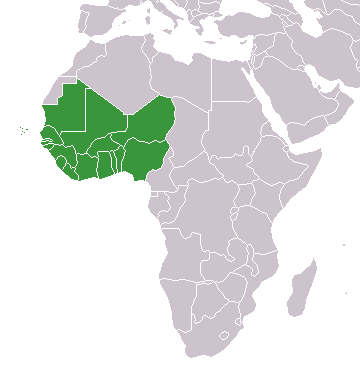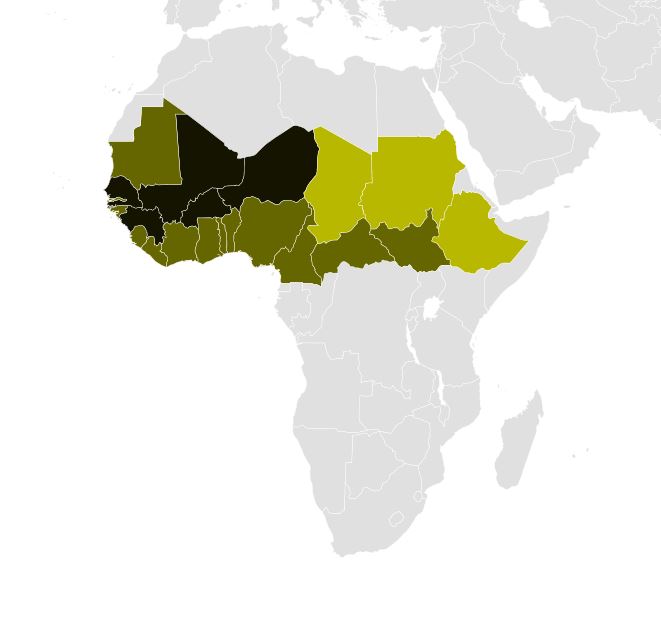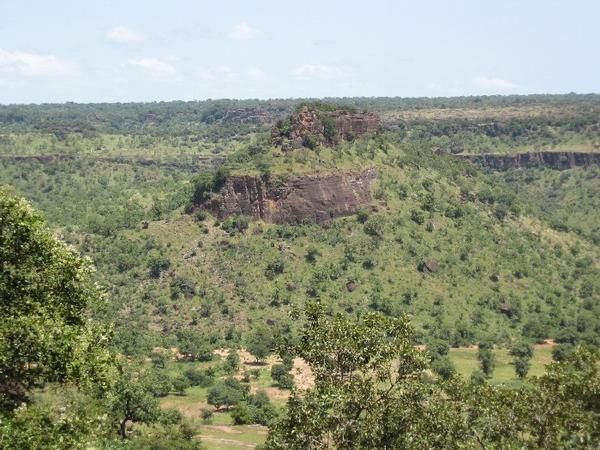|
Samory Touré
Samori Ture ( – June 2, 1900), also known as Samori Toure, Samory Touré, or Almamy Samore Lafiya Toure, was a Mandinka people, Malinke and a Soninke people, Soninke Muslim cleric, military strategist, and founder of the Wassoulou Empire, an Islamic empire that was stretched across present-day north and eastern Guinea, north-eastern Sierra Leone, southern Mali, northern Côte d'Ivoire and part of southern Burkina Faso. A deeply religious Muslim of the Maliki school of fiqh, religious jurisprudence of Sunni Islam, he organized his empire and justified its expansion with Islamic principles. Ture resisted French colonial rule in West Africa from 1882 until his capture in 1898. He was the great-grandfather of Guinea's first president, Ahmed Sékou Touré. Early life and career Samori Ture was born in Manyambaladugu, the son of Kemo Lanfia Ture, a Dyula people, Dyula weaver and merchant, and Sokhona Camara. The family moved to Sanankoro soon after his birth. Ture grew up as West ... [...More Info...] [...Related Items...] OR: [Wikipedia] [Google] [Baidu] |
Almamy
Almami (; Also: Almamy, Almaami) was the regnal name of Tukulor monarchs from the eighteenth century through the first half of the twentieth century. It is derived from the Arabic Al-Imam, meaning "the leader", and it has since been claimed as the title of rulers in other West African theocratic monarchies. Famous holders of the title * Ibrahim Sori, Imamate of Futa Jallon. * Karamokho Alfa, Imamate of Futa Jallon * Bokar Biro, Imamate of Futa Jallon * Almamy Ahmadou of Timbo *Almany Niamody of the Toucouleur vassal state of Kaarta. *Samori Ture of the Wassoulou Empire. * Maba Diakhou Bâ, almamy of Rip in the Saloum region of Senegal. Places * Almami Rural LLG in Papua New Guinea Proper name In recent times the word has become a proper name in some areas of West Africa in honor of the historical figures known by the title. Malian independence leader Almamy Sylla and Guinean football player Almamy Schuman Bah are examples. References *B. A. Ogot(ed). Africa from the Sixt ... [...More Info...] [...Related Items...] OR: [Wikipedia] [Google] [Baidu] |
West Africa
West Africa, also known as Western Africa, is the westernmost region of Africa. The United Nations geoscheme for Africa#Western Africa, United Nations defines Western Africa as the 16 countries of Benin, Burkina Faso, Cape Verde, The Gambia, Ghana, Guinea, Guinea-Bissau, Ivory Coast, Liberia, Mali, Mauritania, Niger, Nigeria, Senegal, Sierra Leone, and Togo, as well as Saint Helena, Ascension and Tristan da Cunha (United Kingdom Overseas Territories, United Kingdom Overseas Territory).Paul R. Masson, Catherine Anne Pattillo, "Monetary union in West Africa (ECOWAS): is it desirable and how could it be achieved?" (Introduction). International Monetary Fund, 2001. The population of West Africa is estimated at around million people as of , and at 381,981,000 as of 2017, of which 189,672,000 were female and 192,309,000 male.United Nations Department of Economic and Social Affairs, Population Division (2017). World Population Prospects: The 2017 Revision, custom data acquired via webs ... [...More Info...] [...Related Items...] OR: [Wikipedia] [Google] [Baidu] |
Milo River
The Milo River is a river in Guinea in West Africa. It rises in the Simandou Mountains near Beyla, flows about to the south of Siguiri and flows north at which point it becomes one of the main tributaries of the River Niger. The pre-colonial Baté Empire was founded in the seventeenth century and was situated in the Milo River valley. In the colonial period, the river was a valuable transportation route, as it was navigable to shallow-draft vessels from Kankan Kankan ( Mandingo: Kánkàn; N’ko: ߞߊ߲ߞߊ߲߫) is the largest city in Guinea in land area, and the third largest in population, with a population of 198,013 people as of 2020. The city is located in eastern Guinea about east of the ... to the Niger River. References Rivers of Guinea Tributaries of the Niger River {{Guinea-river-stub ... [...More Info...] [...Related Items...] OR: [Wikipedia] [Google] [Baidu] |
Fula People
The Fula, Fulani, or Fulɓe people are an ethnic group in Sahara, Sahel and West Africa, widely dispersed across the region. Inhabiting many countries, they live mainly in West Africa and northern parts of Central Africa, South Sudan, Darfur, and regions near the Red Sea coast in Sudan. The approximate number of Fula people is unknown, due to clashing definitions regarding Fula ethnicity. Various estimates put the figure between 25 and 40 million people worldwide. A significant proportion of the Fula – a third, or an estimated 7 to 10 million – are pastoralism, pastoralists, and their ethnic group has the largest nomadic pastoral community in the world., Quote: The Fulani form the largest pastoral nomadic group in the world. The Bororo'en are noted for the size of their cattle herds. In addition to fully nomadic groups, however, there are also semisedentary Fulani – Fulbe Laddi – who also farm, although they argue that they do so out of necessity, not choice. The major ... [...More Info...] [...Related Items...] OR: [Wikipedia] [Google] [Baidu] |
Bissandougou
Bissandugu () is a city in southwestern Guinea on National Road 1. In the 19th century, it was the base for Samori Ture, a Dyula warlord who named the city in 1878 as the capital of his Wassoulou Empire (1878-1890). He was known for his resistance to French colonial forces and prevailed for years against them and smaller African states. History The Treaty of Bissandugu was signed there on the 25 March 1887. The treaty had France obtain major rights of navigation on the Niger River, an important prelude to the French conqueests of West Africa. The treaty also delimited the Wassoulou Empire's borders with France and made the Wassoulou Empire a French protectorate. On April 9, 1891, the city was attacked and burned by French forces commanded by Colonel Louis Archinard during the Mandingo Wars. The French colonial administration re-established control in the area. [...More Info...] [...Related Items...] OR: [Wikipedia] [Google] [Baidu] |
Manding Region
Manding, Manden or even Mandé is a region located in West Africa, a space between southern Mali and eastern Guinea. It is the historic home of the Manding languages, Mandinka community. The Malinke people, Malinke are at the origin of the foundation of the largest empires in West Africa. Among the many groups linked to or originating from Manding, there are the Bambara people, Bambara, the Dyula people, Dyula, the Khassonké people, Khassonke, the Konianké, the Mahou, Koyaka, the Dafing, the Bobo-Dioula and the Kuranko people, Kuranko. Toponymy According to Camara Laye, transcribing the words of griot Babou Condé, the name "Mandén" means "child of the hippopotamus" ("Man" meaning "hippopotamus" or "manatee" and "den" "child"). Geography The climate of Mande is called Sudanese. It is characterized by the alternation of seasons: a rainy season and a dry season. It is the domain of the savannah which is distinguished by shrub vegetation. This region is characterized by the ... [...More Info...] [...Related Items...] OR: [Wikipedia] [Google] [Baidu] |
Cissé
Cissé is a common West African name of Soninke origin, and the meaning of Cissé is the white horse in the same language. Cahiers d'études africaines 2006 "Le nom Cissé au Mali fait partie des noms de famille maraboutiques, tout comme Touré que l'on retrouve en milieu peul, soninké, songhai et malinké." ("The name Cissé in Mali is one of a number of family names of marabout lineage, just as one finds Touré among the Fulani, Soninke, Songhai, and Mandinka.") Notable people with the surname include: Sports * Abdoulaye Cissé (b. 1983), Burkinabé footballer * Aboubacar Cissé (b. 1969), Ivorian footballer * Aliou Cissé (b. 1976), Senegalese footballer and coach * Amadou Cissé (b. 1985), French-Guinean footballer * Babacar Cissé (b. 1975), Senegalese basketball player * Brahima Cissé (b. 1976), Burkinabé footballer * Djibril Cissé (b. 1981), French footballer * Édouard Cissé (b. 1978), French footballer * Fousseyni Cissé (b. 1989), French footballer * Ib ... [...More Info...] [...Related Items...] OR: [Wikipedia] [Google] [Baidu] |
Kola Nuts
The kola nut ( Yoruba: ''obi'', Dagbani: ''guli'', Hausa: goro, Igbo: ''ọjị'', Sängö: ''gôro,'' Swahili: ''mukezu'') is the seed of certain species of plant of the genus ''Cola'', placed formerly in the cocoa family Sterculiaceae and now usually subsumed in the mallow family Malvaceae (as subfamily Sterculioideae). These cola species are trees native to the tropical rainforests of Africa. Their caffeine-containing seeds are used as flavoring ingredients in various carbonated soft drinks, from which the name ''cola'' originates. Description About across, the kola nut is a nut of evergreen trees of the genus ''Cola'', primarily of the species ''Cola acuminata'' and '' Cola nitida''. ''Cola acuminata'', an evergreen tree about 20 meters in height, has long, ovoid leaves pointed at both the ends with a leathery texture. The trees have cream-white flowers with purplish-brown striations, and star-shaped fruit consisting of usually 5 follicles. Inside each follicle, ab ... [...More Info...] [...Related Items...] OR: [Wikipedia] [Google] [Baidu] |
Firearms
A firearm is any type of gun that uses an explosive charge and is designed to be readily carried and operated by an individual. The term is legally defined further in different countries (see legal definitions). The first firearms originated in 10th-century China, when bamboo tubes containing gunpowder and pellet projectiles were mounted on spears to make the portable fire lance, operable by a single person, which was later used effectively as a shock weapon in the siege of De'an in 1132. In the 13th century, fire lance barrels were replaced with metal tubes and transformed into the metal-barreled hand cannon. The technology gradually spread throughout Eurasia during the 14th century. Older firearms typically used black powder as a propellant, but modern firearms use smokeless powder or other explosive propellants. Most modern firearms (with the notable exception of smoothbore shotguns) have rifled barrels to impart spin to the projectile for improved flight stability. ... [...More Info...] [...Related Items...] OR: [Wikipedia] [Google] [Baidu] |
Artisan
An artisan (from , ) is a skilled craft worker who makes or creates material objects partly or entirely by hand. These objects may be functional or strictly decorative, for example furniture, decorative art, sculpture, clothing, food items, household items, and tools and mechanisms such as the handmade clockwork movement of a watchmaker. Artisans practice a craft and may through experience and aptitude reach the expressive levels of an artist. History The adjective "artisanal" is often used in describing hand-processing in contrast to an industrial process, such as in the phrase '' artisanal mining''. Thus, "artisanal" is sometimes used in marketing and advertising as a buzz word to describe or imply some relation with the crafting of handmade food products, such as bread, beverages, cheese or textiles. Many of these have traditionally been handmade, rural or pastoral goods but are also now commonly made on a larger scale with automated mechanization in factorie ... [...More Info...] [...Related Items...] OR: [Wikipedia] [Google] [Baidu] |
Europeans
Europeans are the focus of European ethnology, the field of anthropology related to the various ethnic groups that reside in the states of Europe. Groups may be defined by common ancestry, language, faith, historical continuity, etc. There are no universally accepted and precise definitions of the terms "ethnic group" and "nationality", but in the context of European ethnography in particular, the terms ''ethnic group'', ''people'', ''nationality'' and ''ethno-linguistic group'' are used as mostly synonymous. Preference may vary in usage with respect to the situation specific to the individual countries of Europe, and the context in which they may be classified by those terms. The total number of national minority populations in Europe is estimated at 105 million people, or 14% of 770 million Europeans in 2002.Christoph Pan, Beate Sibylle Pfeil (2002), Minderheitenrechte in Europa. Handbuch der europäischen Volksgruppen', Braumüller, (Google Books, snippet view). Als2006 rep ... [...More Info...] [...Related Items...] OR: [Wikipedia] [Google] [Baidu] |






